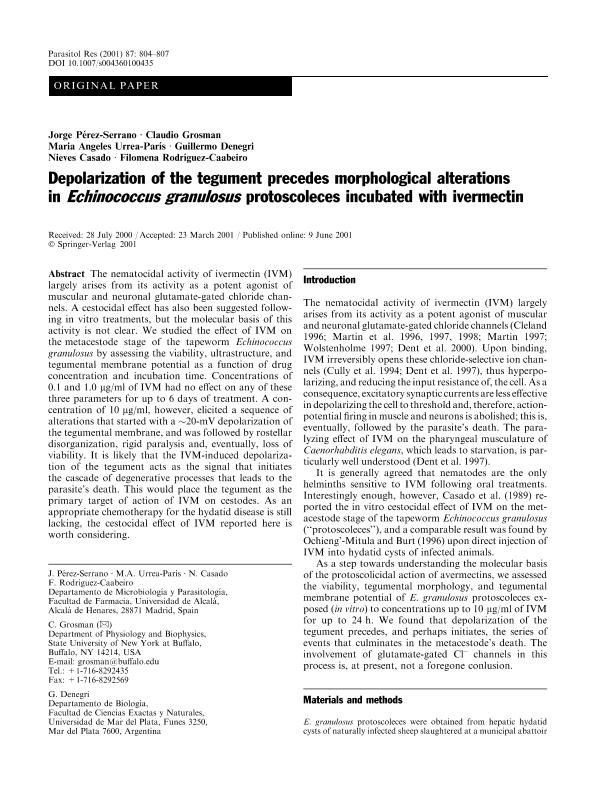Artículo
Depolarization of the tegument precedes morphological alterations in Echinococcus granulosus protoscoleces incubated with ivermectin
Pérez Serrano, Jorge; Grossmann, Claudio; Urrea París, María Ángeles; Denegri, Guillermo Maria ; Casado, Nieves Maria Claudia; Rodriguez Caabeiro, Filomena
; Casado, Nieves Maria Claudia; Rodriguez Caabeiro, Filomena
 ; Casado, Nieves Maria Claudia; Rodriguez Caabeiro, Filomena
; Casado, Nieves Maria Claudia; Rodriguez Caabeiro, Filomena
Fecha de publicación:
12/2001
Editorial:
Springer
Revista:
Parasitology Research
ISSN:
0932-0113
Idioma:
Inglés
Tipo de recurso:
Artículo publicado
Clasificación temática:
Resumen
The nematocidal activity of ivermectin (IVM) largely arises from its activity as a potent agonist of muscular and neuronal glutamate-gated chloride channels. A cestocidal effect has also been suggested following in vitro treatments, but the molecular basis of this activity is not clear. We studied the effect of IVM on the metacestode stage of the tapeworm Echinococcus granulosus by assessing the viability, ultrastructure, and tegumental membrane potential as a function of drug concentration and incubation time. Concentrations of 0.1 and 1.0 μg/ml of IVM had no effect on any of these three parameters for up to 6 days of treatment. A concentration of 10 μg/ml, however, elicited a sequence of alterations that started with a ∼20-mV depolarization of the tegumental membrane, and was followed by rostellar disorganization, rigid paralysis and, eventually, loss of viability. It is likely that the IVM-induced depolarization of the tegument acts as the signal that initiates the cascade of degenerative processes that leads to the parasite's death. This would place the tegument as the primary target of action of IVM on cestodes. As an appropriate chemotherapy for the hydatid disease is still lacking, the cestocidal effect of IVM reported here is worth considering.
Archivos asociados
Licencia
Identificadores
Colecciones
Articulos(CCT - MAR DEL PLATA)
Articulos de CTRO.CIENTIFICO TECNOL.CONICET - MAR DEL PLATA
Articulos de CTRO.CIENTIFICO TECNOL.CONICET - MAR DEL PLATA
Citación
Pérez Serrano, Jorge; Grossmann, Claudio; Urrea París, María Ángeles; Denegri, Guillermo Maria; Casado, Nieves Maria Claudia; et al.; Depolarization of the tegument precedes morphological alterations in Echinococcus granulosus protoscoleces incubated with ivermectin; Springer; Parasitology Research; 87; 10; 12-2001; 804-807
Compartir
Altmétricas



